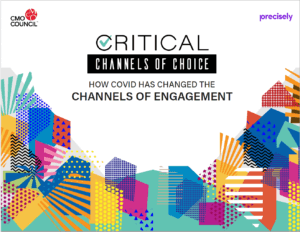|
|
 Consumers across generations and geographies are flocking to digital self-service channels when engaging with brands, yet many get frustrated when their needs aren’t met. This frustration has led to 73% of consumers questioning why they’re doing business with the brand.
Consumers across generations and geographies are flocking to digital self-service channels when engaging with brands, yet many get frustrated when their needs aren’t met. This frustration has led to 73% of consumers questioning why they’re doing business with the brand.
A new Chief Marketing Officer (CMO) Council report, produced in partnership with Precisely, entitled “How Covid Has Changed The Channels Of Engagement,” covers critical channels of exploration and engagement, the rise of digital channels such as interactive and personalized video, the influential role of traditional channels, problems that cause consumer frustration and brand abandonment, and how different generations prefer to engage with brands.
Key findings include:
* Top five channels of engagement that consumers expect from brands include: email, website, voice call, live person and SMS text
* 65% percent of consumers say digital engagements with brands during the global pandemic is not exceeding expectations
* 87% percent find it frustrating when needing to engage in multiple channels and having to repeat themselves in every new channel
* 21% chose digital-only when asked to identify their ideal communication preferences, up from 10% last year
* 50% cite the ability to escalate to a live person when needed is the most important trait when engaging with a brand, followed by personalized communication based on previous interactions (44%) and the ability to digitally self-serve to get to answers quickly (30%)
The urgency to deliver a seamless digital experience across the key channels of engagement has only increased as the current pandemic continues to push consumers online. The report shows how this has exposed brands’ digital shortcomings.
Problems include consumers lacking an escalation path to a live person, receiving non-personalized or out-of-context messages, having to repeat themselves in different channels, and being unable to pivot to channels of their choosing.
“For years, brands have touted robust digital transformations, that is, their ability to engage with customers digitally,” notes Donovan Neale-May, executive director of the CMO Council. “The pandemic accelerated this by forcing consumers to turn to digital channels, thus putting a brand’s digital transformation to the test. The result was that many brands’ digital channels were lacking in some way.”
The report also found differences among generations in their channel-engagement preferences. Gen Zers, for instance, are more likely to exhaust digital self-service channels before reaching out to a live person. Younger generations were also more willing to share personal data in exchange for better, faster and more personalized service.
“Seamless, personalized and digital self-service experiences across the key channels of engagement are what’s driving the customer experience of tomorrow,” explains Greg Van den Heuvel, EVP and GM at Precisely for EngageOne. “When customers are moving between channels, don’t make them reintroduce themselves each time. The experience has to be frictionless and must take into account the previous engagement they’ve had with your organization. Those that fail to embrace the ‘new normal’ and deliver seamless digital experiences will fall further behind their competition.”
